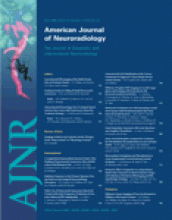Research ArticleBRAIN
Vital Signs Investigation in Subjects Undergoing MR Imaging at 8T
M. Yang, G. Christoforidis, A. Abduljali and D. Beversdorf
American Journal of Neuroradiology April 2006, 27 (4) 922-928;
M. Yang
G. Christoforidis
A. Abduljali

References
- ↵Robitaille PM, Abduljalil AM, Kangarlu A, et al. Human magnetic resonance imaging at 8T. NMR Biomed 1998;11:263–65
- Christoforidis GA, Bourekas EC, Baujan M, et al. High resolution MRI of the deep brain vascular anatomy at 8 Tesla: susceptibility-based enhancement of the venous structures. J Comput Assist Tomogr 1999;23:857–66
- ↵Robitaille PM, Abduljalil AM, Kangarlu A. Ultra high resolution imaging of the human head at 8 Tesla: 2K x 2K for Y2K. J Comput Assist Tomogr 2000;24:2–8
- ↵Schenck JF. Safety of strong, static magnetic fields. J Magn Reson Imaging 2000;12:2–19
- ↵
- ↵Schenck JF. Health and physiological effects of human exposure to whole-body four-Tesla magnetic fields during MRI. Ann N Y Acad Sci 1992;649:285–301
- ↵Schaefer DJ. Safety aspects of switched gradient fields. Magn Reson Imaging Clin North Am 1998;6:731–48
- Ham CL, Engels JM, van de Wiel GT, et al. Peripheral nerve stimulation during MRI: effects of high gradient amplitudes and switching rates. J Magn Reson Imaging 1997;7:933–37
- ↵
- ↵Shellock FG. Radiofrequency energy-induced heating during MR procedures: a review. J Magn Reson Imaging 2000;12:30–36
- ↵Schaefer DJ. Safety aspects of radiofrequency power deposition in magnetic resonance. Magn Reson Imaging Clin N Am 1998;6:775–89
- ↵High WB, Sikora J, Ugurbil K, et al. Subchronic in vivo effects of a high static magnetic field (9.4 T) in rats. J Magn Reson Imaging 2000;12:122–39
- ↵
- ↵
- ↵Kangarlu A, Burgess RE, Zhu H, et al. Cognitive, cardiac, and physiological safety studies in ultra high field magnetic resonance imaging. Magn Reson Imaging 1999;17:1407–16
- ↵Kangarlu A, Shellock FG, Chakeres DW. 8.0-Tesla human MR system: temperature changes associated with radiofrequency-induced heating of a head phantom. J Magn Reson Imaging 2003;17:220–26
- ↵Guidance for Industry and FDA Staff: Criteria for Significant Risk Investigations of Magnetic Resonance Diagnostic Devices. U.S. Department of Health and Human Services, Food and Drug Administration, Center for Devices and Radiological Health;2003;1–5
- ↵
- ↵Keltner JR, Roos MS, Brakeman PR, et al. Magnetohydrodynamics of blood flow. Magn Reson Med 1990;16:139–49
- ↵Shellock FG. Cutaneous blood flow changes during MR imaging. AJR Am J Roentgenol 1988;151:1059–60
- ↵Shellock FG, Crues JV. Temperature, heart rate, and blood pressure changes associated with clinical MR imaging at 1.5T. Radiology 1987;163:259–62
- ↵Shellock FG, Crues JV. Temperature changes caused by MR imaging of the brain with a head coil. AJNR Am J Neuroradiol 1988;9:287–91
- ↵Shellock FG, Crues JV. MR procedures: biologic effects, safety, and patient care. Radiology 2004;232:635–52
- ↵Shellock FG. Thermal responses in human subjects exposed to magnetic resonance imaging. Ann N Y Acad Sci 1992;649:260–72
- ↵Shellock FG, Myers SM, Kimble KJ. Monitoring heart rate and oxygen saturation with a fiber-optic pulse oximeter during MR imaging. AJR Am J Roentgenol 1992;158:663–64
- ↵Shellock FG, Schaefer DJ, Kanal E. Physiologic responses to an MR imaging procedure performed at a specific absorption rate of 6.0 W/kg. Radiology 1994;192:865–68
- Shellock FG, Shields CL Jr. Temperature changes associated with radiofrequency energy-induced heating of bovine capsular tissue: evaluation of bipolar RF electrodes. Arthroscopy 2000;16:348–58
- ↵Shellock FG. Radiofrequency energy induced heating of bovine capsular tissue: in vitro assessment of newly developed, temperature-controlled monopolar and bipolar radiofrequency electrodes. Knee Surg Sports Traumatol Arthrosc 2002;10:254–59
- ↵Bourland JD, Nyenhuis JA, Schaefer DJ. Physiologic effects of intense MR imaging gradient fields. Neuroimaging Clin North Am 1999;9:363–77
- ↵Budinger TF, Fischer H, Hentschel D, et al. Physiological effects of fast oscillating magnetic field gradients. J Comput Assist Tomogr 1991;15:909–14
- ↵United States Food and Drug Administration. Guidance for content and review of a magnetic resonance diagnostic device 510(k) application: safety parameter action levels. Center for Devices and Radiological Health Report. Rockville, MD: US FDA;1988
- ↵International Electrotechnology Commission. Particular requirements for the safety of agnetic resonance equipment for medical diagnosis. In: Diagnostic imaging equipment, publication IEC 60601–2-33, medical electrical equipment. Part 2. Geneva, Switzerland: International Electrotechnology Commission;1995
- ↵Hojgaard MV, Holstein-Rathlou NH, Agner E, et al. Reproducibility of heart rate variability, blood pressure variability and baroreceptor sensitivity during rest and head-up tilt. Blood Press Monit 2005;10:19–24
- ↵Khoury AF, Sunderajan P, Kaplan NM. The early morning rise in blood pressure is related mainly to ambulation. Am J Hypertens 1992;5:339–44
- ↵
In this issue
Advertisement
M. Yang, G. Christoforidis, A. Abduljali, D. Beversdorf
Vital Signs Investigation in Subjects Undergoing MR Imaging at 8T
American Journal of Neuroradiology Apr 2006, 27 (4) 922-928;
0 Responses
Jump to section
Related Articles
- No related articles found.
Cited By...
This article has not yet been cited by articles in journals that are participating in Crossref Cited-by Linking.
More in this TOC Section
Similar Articles
Advertisement











